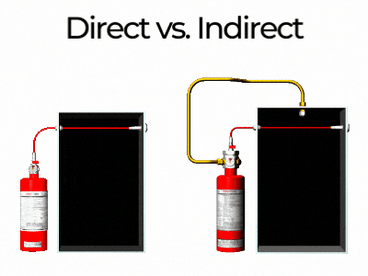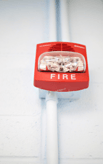Understanding the components that make up a fire protection system in buildings is essential for owners and safety managers to confidently decide which is the best fire suppression system for their needs. Knowing the different components supports an efficient installation, allows company stakeholders to monitor the progress of the project, and offers perspective on the final costs.
What Are the Two Types of Fire Suppression Systems?
When considering a protection system, it’s important to know the two different types of fire suppression systems: direct and indirect. 1. Direct release fire suppression systems get their name from the fire-suppressing agent that discharges through a hole that bursts the detection tube to target the fire at the source. These types of systems are commonly found in server rooms and in other areas where electrical arcs could intensify fires during suppression attempts. Keep in mind, these direct systems may be installed in areas where the entire room or space could be damaged.
1. Direct release fire suppression systems get their name from the fire-suppressing agent that discharges through a hole that bursts the detection tube to target the fire at the source. These types of systems are commonly found in server rooms and in other areas where electrical arcs could intensify fires during suppression attempts. Keep in mind, these direct systems may be installed in areas where the entire room or space could be damaged.
2. Indirect release fire suppression systems are slightly different from the direct systems. In this case, a fire-suppressing agent is discharged through overhead sprinklers or dedicated nozzles that can be separate or combined with the fire detection system. So, one component detects the fire, and a separate component suppresses it. If appropriate, these systems may release water, too.
What Are the Components of a Fire Protection System?

The basic components of a fire protection system include detection methods, alarms and notification devices, control panels, power supplies, the release mechanisms, and the suppressants themselves.
Here’s the rundown:
- Fire Alarm Initiation Devices: When a fire is detected, the initiation devices activate the fire suppression system. Some systems require manual initiation by a person in the facility, while others are engineered to activate automatically. A direct release system will automatically trigger at a certain temperature or in the presence of fire. On the other hand, an indirect release system can be automatically triggered or activated by another means of a detection system.
- Fire Notification Devices: You’re probably familiar with this one. Fire notification devices notify people in the building that there is a fire. These typically include alarms, bells, horns, or other sounds and strobe lights. When these go off, always look for illuminated exit signs and pathways to evacuate safely.
- Alarm Monitoring Systems: These sometimes-optional components integrate with the systems of local fire departments to automatically notify them when an alarm is triggered at the location.
- Alarm Control Panels: These are the components that allow the fire alarm to be turned off once it is triggered. Sometimes, facility managers or safety managers may have access to these controls, while in other cases the fire department alone can turn off the alarm once they determine the fire is extinguished.
- Suppressant Delivery Systems: The functional elements of the fire protection system. This includes the water, chemical clean agent, and/or gases that suppress the fire, the pipes or tubes that carry the suppressant to the fire, and the release mechanisms like nozzles, sprinklers, or temperature-sensitive tubes.
- Primary and Backup Power Supplies: Depending on the type of fire suppression system, some will either be hard-wired into the electrical infrastructure of your building or sustained through an external power supply that the power company provides. In contrast, other systems do not require any electricity to activate the system. When using a system that requires electricity, we recommend a backup power supply such as batteries to keep the system running even during a power outage.

